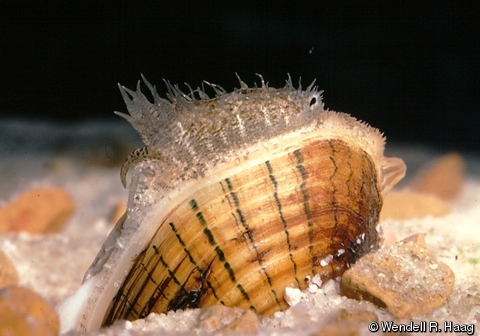With the watershed spanning over 5,000 square miles and 220 miles of river, getting to know the Coosa and her creeks is a lengthy project.
“Getting to Know the Coosa” is a series of blog posts that will be highlighting special areas on the Coosa River. These posts are written by different individuals in the watershed that find a connection with a specific part of the river. Whether they spent their whole lives fishing, swimming or boating on their favorite lake, or they recently have formed a connection with a little creek, “Getting to Know the Coosa” puts you in the shoes of another river lover for a few paragraphs, explaining the endless ways to love a river.

Karli, James & Frank checking out the IMPACT the crater had on the most paddled portion of the Coosa.
This segment was written by James Lowery. James, retired from UAB, considers himself to be an “amateur scientist”. He has spent his retirement contributing to the future of Alabama’s environmental movement, by sitting on 8 different organizations boards including Alabama Water Watch and Legacy Environmental Education!
In between board meetings, he has traveled the world- literally. He has been to 6 continents with his favorite vacation destination being Antartica! Although he has seen the world, James still holds Alabama near and dear to his heart.
Stars fell on Alabama…
As James is continually finding ways to make an impact in his community it would only make sense that he is fascinated with the biggest impact that Alabama has ever seen, the Wetumpka Impact Crater.
“What do the Coosa River and Wetumpka have to do with an Asteroid from Outer Space?”
By James Lowery
Think back with me 85 million years ago.
There was no Alabama.
There was no Coosa River.
Definitely no Wetumpka.
Sandy ocean beaches and shallow marine water took over the landscape that we are familiar with today. Dinosaurs roamed the area, and dinosaur-era “sea creatures” swam in the off-shore waters.
Then one fateful day 85 million years ago, suddenly from outer space a huge, rocky object came screaming through the sky and exploded as it hit the Earth at over 43,000 miles per hour where Wetumpka, Alabama, is today.

Check out all that Mountain Laurel!
The explosive force of a 1,200-foot-wide chondrite asteroid (as big as a college football stadium) hitting the Earth killed all the dinosaurs in that part of the future Alabama; completely re-shaped the landscape; and left a 4-mile-wide, over 400-foot-high crater of solid rock on the landscape for us to marvel at and to enjoy even today.

The crater has created it’s own microclimate, so different vegetation is seen inside the crater walls then anywhere in the costal plain!
What does this have to do with the Coosa River?
As you drive along US Highway 231 in Wetumpka, notice that it curves gently as it follows a “hill” on the east side of the highway and the Coosa River on the west side. That curve and the “bend” in the river are there because the highway and the river are curving around the outside of the western rim of the crater left by the asteroid impact and explosion.
Downtown Wetumpka and a lot of the residential areas are built on and, in a lot of cases inside.


As a matter of fact, when you see any of the hills near or in Wetumpka, you are seeing the impact crater!
Ever wondered why the Wetumpka section of the Coosa is so unique?

Drone footage of the most paddled section of the Coosa courtesy of Bram Odrezin
The Coosa River near Wetumpka, you are paddling alongside, and in some places on, the western side of an impact crater also known as an astrobleme (“star-wound”)!
But that’s not all!
How does the name “Wetumpka” relate to the Coosa River and especially to the impact crater?
“Wetumpka” was the Native American term for “rumbling waters,” and that is the sound they associated with the river water rushing over the up-turned layers of rock in the Coosa River at Wetumpka. You may by now have guessed that those rock layers were up-turned from their original horizontal positions by the massive impact explosion that created the Wetumpka Impact Crater.
In closing, let’s try to get a feel for the massiveness of the explosion that created this crater.
We can do that by looking at the Wetumpka Impact Crater Timeline as follows:
0.00 Second – Forward shock wave begins travel into Earth, and reverse shock wave begins travel BACK into asteroid.
0.02 Second – Asteroid reaches depth of 1,000 feet into the ground.
0.02 Second – Shock wave reaches the back end of the asteroid, and it is vaporized yielding 100 to 1,000 MEGATONS of energy. (175,000 times the energy of the Hiroshima bomb)
0.02 Second – Flashfires reach to a radius of over 31 MILES; TOTAL fire area probably was more than 3,000 square miles. (Would have disintegrated Montgomery, Auburn, Clanton, probably some of Birmingham.)
0.02 Second – First ejecta material leaves the crater at 159,000 miles per hour.
0.60 Second – First ejecta material reaches outer space (goes into orbit around the Earth).
2.00 Seconds – Shock wave reaches out to 25 miles, FLATTENING everything in its path. TOTAL flattened area probably was more than 2,000 square miles. Middle part of Alabama and Georgia are flattened; DINOSAURS IN THE AREA ARE KILLED.
2.00 Seconds – Tsunami wave reaches height of 39-128 feet high and extends out to a distance of 5,000 feet from the crater.
11.5 Seconds – Crater opens (4-mile-wide crater composed of solid rock is created.)
26.0 Seconds – Central rebound hill reaches its maximum height of 200 feet.
In less than 30 Seconds – Crater RIM was raised to its final height and position.
203 Seconds (In just over 3 MINUTES) – Crater ejecta has reached out to a distance of 13 MILES from the crater.
FOR THE WETUMPKA CRATER, this was not the end – The tsunami backwash crashed back into the crater, destroying the southwest rim!
If it happened today, there would be at least 400,000 human casualties!! (Did I mention that it is Alabama’s greatest natural disaster?)
So, as you enjoy the Coosa River at Wetumpka, think back 85 million years and enjoy the massive Wetumpka crater and its “impact” on the area.




